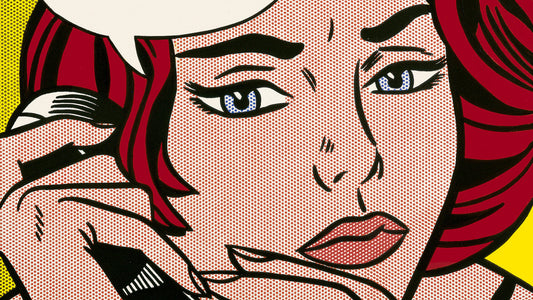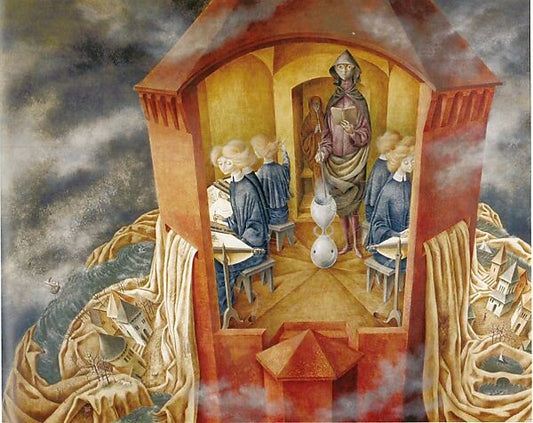Feature image: Remedios Varo Bordando el manto terrestre (Embroidering the Earth's Mantle), 1961, Gallery Wendi Norris via Artsy
Witches appeared in art history as mysterious women practicing rituals by a fire. Before the Salem witch trials during the 17th century, classical art depicted witches practicing magic and ceremonial rituals. It was a combination of mythology and history of witchcraft. The witches were seen as a group of women dancing nude, witnessing a sacrifice, or casting a spell by a cauldron. Between the fourteenth and eighteenth centuries, artists Albrecht Durer, Salvator Rosa, Francisco de Goya, and John William Waterhouse drew and painted them, having been influenced by witch hunts, trials, Christianity, mythology, and executions. Hence, these artists focused on supernatural activities among the witches. The early paintings of witchcraft and paranormal activity became the inspiration for movies like Teen Witch (1989), Hocus Pocus (1993), The Crucible (1996), Halloween Town (1998), Kiki’s Delivery Service (1998), and the Harry Potter franchise. A social and historical context, they influenced the depiction of witches in art through the events of witch hunts, the Salem witch trials, Christianity, and mythology.

In 1497, Albrecht Durer, a German Renaissance artist, completed an engraving called The Four Witches. The title of his work is the English translation of the original title, the German saying being, “Die Vier Hexen.” Durer’s engraving came out during the Dark Ages. The engraving reveals a coven of four nude women dancing. In 2021, Artsper Magazine wrote how the witches “are accompanied by a small horned demon to the left of the center, an overt symbol of the Devil. Skulls and bones scattered on the floor may symbolize death, magic, or innovation from an evil deity.” The demon, the skulls, and the bones on the floor are all signs of witchcraft. Thus, Durer’s work is one of the first pieces of art depicting witchcraft.
In 1646, Salvator Rosa, an Italian painter famous during the Baroque era, painted Witches at their Incantations; this is an oil on canvas. Like Durer’s work, Rosa continued with the theme of witchcraft. The time frame of Rosa’s painting is during “the height of the witch mania spreading throughout Europe.” His painting focuses on many different characters, such as an elderly naked woman, a baby, a hanging body, and many other people, monsters, and skeletons. The characters have gathered around to conduct a sacrifice of a baby. The Artsper Magazine states, “The scene portrays a witches’ sabbath, a satanic inversion of a Christian mass. It’s an illustration of the fear heretics can survive undetected within a God–fearing community.” Rosa focused on how religious figures, like priests, used their Christian faith to propagate fear, which “encouraged the demonization of women who were perhaps outsiders, unmarried, vulnerable.” Rosa’s painting is an example of Christianity's power over a community. Thus, religious figures targeted women who were outsiders of witchcraft.

In 1797, Francisco de Goya, a Spanish painter and graphic artist, painted an oil on canvas titled Witches’ Flight, which conveys the themes of fear and eeriness throughout the composition. According to an article from Dark Gloomy Art, Goya’s work is “an oil painting featuring a nightmarish scene of a flock of witches soaring across a black sky.” This may very well be “related to a Spanish Inquisition topic.” A fearful individual is being lifted into the air by flying witches wearing pointy hats and baggy, colorful pants. Through this painting, fear is seen through the violence and butchery of the individual. Goya’s painting has very eerie characters and has a “mysterious presence throughout the composition.” It’s possible this individual is being offered as a sacrifice for the witches because below are two humans and a donkey bowing their heads. The painting is Goya’s “most important works, becoming a symbol of troubled times full of superstitions and unjust practices haunting humanity today.”


A year later, in 1798, Goya painted an additional oil on canvas called Witches’ Sabbath. He attempted to give a supernatural vibe to the witches surrounded by a goat. According to Dark Gloomy Art, Goya’s painting “is an unsettling representation of a supernatural gathering. The goat, who’s in the middle of the gathering, is the focus, and he’s surrounded by a group of witches, “who are ready for their sabbath ritual to begin.” The women sitting around him are all clothed, and they’re holding their babies. In fact, “All of them appear to be preparing for something sinister as if they were conjuring a ritual.” The sinister act could be offering their babies as a sacrifice for the goal. The closer viewers look, one of the women holds up the skeleton of her baby.
In 1886, an English painter, John William Waterhouse, completed The Magic Circle, an oil on canvas painting part of the Pre-Raphaelite style. Waterhouse was known for painting mythological women, so it’s no surprise how his painting, The Magic Circle, focuses on a witch by her cauldron. The witch he’s painted is a “mysterious figure” because viewers cannot see her face because her hair hides it. The details of the witch are important to Waterhouse’s painting because it represents the supernatural activity she’s conducting by the cauldron. According to Dark Gloomy Art, “She wears an ornate robe of midnight blue velvet, gathered tightly around her slight frame to emphasize her status as a supernatural being.” In addition to making her a supernatural being, she’s standing inside a barrier of stones that circle her - the magic circle. Moreover, she has a snake wrapped around her neck and a long wand in her hand. She is a witch ready to cast a spell.

During the fourteenth and eighteenth centuries, Albrecht Durer, Salvator Rosa, Francisco de Goya, and John William Waterhouse depicted witches in early art history. The paintings are similar because they represent witchcraft and supernatural activities in action among women outside. Yet, the paintings differ because they don’t all focus on a child being sacrificed. Regardless, Durer, Rosa, de Goya, and Waterhouse were inspired by the Salem witch trials, Christianity, and mythology. Thus, they gave their spinoff of what they knew within their era. Witches and their power of forming a coven and supernatural abilities have continued to fascinate art, cinema, and generations during Halloween.
©ArtRKL™️ LLC 2021-2023. All rights reserved. This material may not be published, broadcast, rewritten or redistributed. ArtRKL™️ and its underscore design indicate trademarks of ArtRKL™️ LLC and its subsidiaries.





